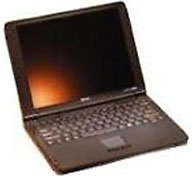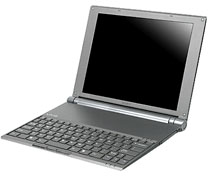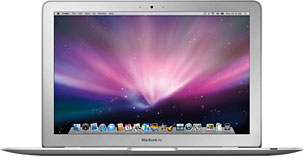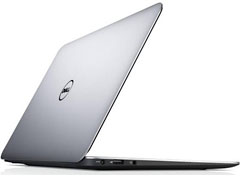I missed CES again, as usual, but there were many people who shared
about some of the great new gadgets coming out. A big headline was the
rash of new ultrabooks. This is great, but I am confused about why
anyone thinks this is news.
Small, lightweight notebooks have been around for years, even before
the original 2008 MacBook
Air.
Apple almost invented the category with the PowerBook Duo 210 and 230 in October 1993, although the Duos
miss the Ultrabook mark in a few respects. Their 10.9" x 8.5" footprint
certainly qualifies, but not their 1.4" thickness or 4.2 lb.
weight.
The First Ultrabooks

HP Sojourn OmniBook
In 1998, HP released the
Sojourn OmniBook, which can be considered the first ultrabook at
just 0.71" thick. The
Sojourn has a 12.1" screen, a 233 MHz Pentium II, and a
conventional laptop hard drive, although one only 8mm thick, a
breakthrough at the time.

Sony VAIO X505
In 2004, Sony released the Vaio X505,
which weighs just 1.85 lb. and ranges from 0.38" to 0.83" thick' it's
wedge-shaped like the MacBook Air. It is powered by an ultra-low power
1.1 GHz Pentium M, and its battery lasts almost three hours.
The original MacBook Air has a larger footprint than
either the HP or Sony, is thinner overall, weighs 3.0 lb., and has a
battery rated at five hours.
Going After the Leader
I guess the news is that this category finally has a leader,
the MacBook Air. Now when someone comes out with a new ultrabook, the
media can all merrily compare it to the MacBook Air. You cannot compare
it to other notebooks, because the features like processor speed,
battery life, etc. are all less than a traditional notebook - and the
cost is higher. The MacBook Air was originally criticized for the same
reasons, but since it was a Mac, it had a different group of buyers
to judge its benefits.
One of the ultrabooks to get special attention was the Dell XPS 13.
It is so new that Dell just launched an official page for preordering
it, but there are not a lot of details. In my search, I came across an
article by Harry McCracken,
Dell's Little Big Ultrabook Looks Like a Winner.
McCracken lays out the usual company marketing info on features,
specifications, and design. But he had two statements that push his
credibility.
"No two manufacturers seem to agree on what an
Ultrabook should be. That's neat, since it means they're
experimenting."
"But the XPS 13 looks way better than the rather odd
Adamos - and it
doesn't look much like a MacBook Air at all."
Does the Dell XPS 13 Beat the MacBook Air?
It's clear that what all manufactures want is to beat the MacBook
Air, either with a bigger screen, more memory, or extra ports. They are
all sick of Apple raking in the big buck while they all compete for low
margin scraps.


13.3" Dell XPS 13 looks a lot like the 13.3" MacBook Air (ignore the
distorted width of the MBA's keyboard)
McCracken should have been able to figure that out, but instead he
thinks Dell is "experimenting". The only experimenting is trying to
figure out what extra features will be enough to take on Apple.

Dell XPS 13
McCracken is also blind to the design of the XPS 13 ultrabook. He
may not think the XPS 13 - with its darker color, sprayed on coating,
and a plastic bottom - is a match for the MacBook Air, but it is clear
from the photos that Dell's marketing departmen tis trying to attract
MacBook Air buyers. Even though the XPS is dark gray, several of the
publicity photos have it lighted in a way so that it looks as bright as
the MacBook Air.
Not only are there obvious design cues to give the publicity photos
the feel of the MacBook Air, the specifications are an even closer
match. (This chart was difficult to compile, because I couldn't find a
good fact page at Dell. I used information from McCracken's article
combined with
data from Dell and
techie-buzz.)
|
Dell XPS 13 |
11" MacBook Air |
13" MacBook Air |
| Display |
13.3" 1366 x 768 |
11.6" 1366 x 768 |
13.3" 1440 x 900 |
| Price |
$999 and up |
$999 - $1,199 |
$1,299 - $1,599 |
| Size - Thickness |
0.24-0.71" |
0.11-0.68" |
0.11-0.68" |
| Size - Width |
12.4" |
11.8" |
12.8" |
| Size - Depth |
8.1" |
7.56" |
8.94" |
| Weight |
2.99 lb. |
2.38 lb. |
2.96 lb. |
| Storage (SSD) |
128 GB - 256 GB |
64 GB - 128 GB |
128 GB - 256 GB |
| Processor |
1.6 GHz Intel Core i5
1.7 GHz Intel Core i7 |
1.6 GHz Intel Core i5
1.8 GHz Intel Core i7 |
1.7 GHz Intel Core i5
1.8 GHz Intel Core i7 |
| Memory |
4 GB |
2 GB - 4 GB |
4 GB |
| Graphics |
Intel HD Graphics 3000 |
Intel HD Graphics 3000 |
Intel HD Graphics 3000 |
| Webcam |
1.3 MP |
720p FaceTime camera* |
720p FaceTime camera* |
| Ports |
1 USB 3.0
1 USB 2.0 with PowerShare
1 mini DisplayPort
1 3.5 mm audio jack |
2 USB 2.0
1 Thunderbolt/mini DisplayPort
1 3.5 mm audio jack |
2 USB 2.0
1 Thunderbolt/mini DisplayPort,
1 3.5 mm audio jack
1 SD Card slot |
| Battery |
Up to 9 hours |
Up to 5 hours |
Up to 7 hours |
| Keyboard |
backlit chiclet keyboard |
backlit chiclet keyboard |
backlit chiclet keyboard |
| Materials |
aluminum lid, carbon-fiber bottom |
aluminum |
aluminum |
If you didn't see the resemblance before, look at the near match for
features. Please explain the keyboard and touchpad. Apple has used a
chiclet keyboard on MacBooks since the first consumer MacBook
shipped in May 2006, and Apple has since implemented it on all their
notebook computers and separate keyboards. Apple was the first to use a
glass touchpad. These showed up in 2008 on the MacBook and MacBook
Pros.
The Dell XPS 13 is definitely a Mac wannabe.
I think Harry McCracken needs to rethink who all these ultrabooks
are trying to be, especially the Dell XPS 13. If they imitated any more
closely, Apple would probably sue them over trade dress issues.
Win Some, Lose Some
The only problem I have with the XPS 13 is that it is a 13" notebook
claiming to be packaged in an 11" size. When compared to the MacBook
Air, this is only partially true. The weight is closer to the 13"
MacBook Air, as is the battery life. Dimensionally it's about midway
between Apple's models (100 square inch footprint vs. 89 for the 11"
MBA and 114 for the 13" MBA).
The disappointing match up is that the screen resolution is the same
1366 x 768 as the 11" MacBook Air. That is not the best comparison for
Dell. In this regard Dell looses to Apple. Apple's 13" MacBook Air has
a higher resolution 1440 x 900 display that Dell's ultrabook lacks.
Dell does win on storage size when compared with the smaller MacBook
Air, starting at 128 GB, memory at 4 GB, and the option for a Blu-ray
drive. If you can live with its screen resolution, the Dell sounds like
a fair deal for Windows users.
It looks like Dell has found a good blend of features to pursue the
MacBook Air market by matching almost everything Apple does. Screen
resolution was the one item that was sacrificed to hit the $999
price.
We'll let the market decide if they made the right choice.








